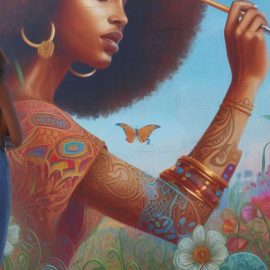

This article is an excerpt from the Shortform summary of "White Fragility" by Robin J. DiAngelo. Shortform has the world's best summaries of books you should be reading.
Like this article? Sign up for a free trial here .
What is white identity? How does a white racial identity treat black people as the “other” race?
White identity is a term that refers to how a white person identifies as part of the white race. Ignoring the power and privileges of white identity, the black race is treated as the “other” race.
Read on to understand white identity and its ramifications.
White Excuses Instead of Acknowledging White Identity
Two common manifestations of white identity deniability (and white fragility) are claims of colorblindness and a professed color celebration, or appreciation of token diversity. They are intended to show that the white speaker is personally free from the social conditioning of white supremacy.
These, however, are merely retreats into the myth of individualism and a refusal to engage with one’s racial biases. Such biases are impossible to escape, as no white person is able to throw off the social conditioning of being raised in a white supremacist society—we are all products of our environment, whether or not we choose to accept it.
We’ve already exposed the hollowness of colorblindness, but it’s worth exploring in greater detail here. Examples of colorblind statements might be:
- A straightforward claim that one doesn’t “see race” or that it doesn’t matter to them
- A claim that one’s parents weren’t racist or taught them to “treat everyone equally.”
These claims blatantly misrepresent the true, insidious nature of racism. It is impossible not to see race, because race is the defining element of the American experience. Moreover, to deny its existence is to invalidate the experiences of people of color, whose lives have very much been shaped by their racial identity.
Similarly, it is impossible to “treat everyone equally” because all individuals have different needs and different relationships to us. Treating different individuals differently based upon circumstance is not the issue. We treat people differently for many reasons that are independent of race. This is a basic part of socialization. The problem arises when this differential treatment is directed at members of groups as a whole and leads to disadvantageous and unjust outcomes.
Meanwhile, a statement of color celebration might be the claim that one can’t be racist because they grew up or live in a diverse city like New York or that they have black friends. But this, too, is absurd. The mere ability to be in the presence of people of another racial identity (as one would inevitably be in a city like New York) without becoming overtly hostile or agitated defines racism so narrowly that it deprives it of any functional meaning. If that’s the standard for racism, then racism would be a very rare phenomenon.
Similarly, having individual friendships with people of color does not invalidate or cancel out the powerful social conditioning that comes with being raised in a white supremacist society. This is especially true if white people refuse to discuss race with their friends of color—thereby denying their friends’ lived experiences.
All of these statements amount to excuses, a refusal to engage in reflection about one’s own participation in a white supremacist society. Instead of helping to spark a dialogue and move the needle forward on dismantling racism, these reflexive defenses forestall any discussion and analysis. In doing so, they help preserve and bolster white supremacy.
Racial learning is a process, and one needs to be willing to engage in tough self-reflection to make progress toward it. Racism is a continuum or a spectrum. A white person will never be entirely free of racist attitudes, but with honesty and a willingness to question one’s own racially problematic behavior, one can move toward the more just end of the continuum.
Black People: The Quintessential “Other” Race
But any analysis of racism should focus on the real victims of it—people of color and, specifically, African-Americans. While other non-white groups have undeniably faced persecution in the United States, black people serve as the ultimate racial “other” for whites.
Some of this is due to more modern manifestations of white supremacy, like media portrayals of black communities as crime-ridden dystopias. But it also comes from the ways in which white identity itself is inextricably tied to notions of black inferiority. As we saw in Chapter 1, our ideas of black racial inferiority arose as a means to justify the systemic oppression of black people during the era of colonization. Before this time, concepts of “black” and “white” would have had little meaning. White people from different parts of Europe during the ancient and medieval periods had no idea of whiteness as a shared characteristic between them.
It was only upon contact with and enslavement of Africans by the millions beginning in the 16th century that a concept of whiteness began to solidify. Of course, for one race to be inferior, the other must, by definition, be superior. The powerful ideology of white supremacy thus needs black people to sustain itself. White identity thus has never existed without black inferiority.

———End of Preview———
Like what you just read? Read the rest of the world's best summary of Robin J. DiAngelo's "White Fragility" at Shortform .
Here's what you'll find in our full White Fragility summary :
- Why white people become defensive when confronted with the idea of racism
- How today's racial hiearchy began in roots centuries ago
- How we as society can gradually overcome our deep racial divides






